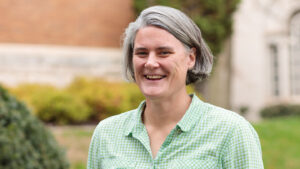Campus experts share insights on how COVID-19 can help us prepare for climate challenges of the future
As COVID-19 has upended life all over the planet and exposed vulnerabilities in many of our systems, it has shed a light on opportunities that can help us better prepare for environmental challenges of the future.
Kira Lawrence, John H. Markle professor of geology and department head, and Delicia Nahman, director of sustainability, participated in a recent webinar sponsored by the Office of Alumni Relations, in which they discussed how the COVID-19 pandemic could be a harbinger of things to come. Here is a brief recap with several takeaways from their talk. You can watch their full presentation and learn about other continuing-ed opportunities here.

Delicia Nahman

Kira Lawrence
Listen to scientists.
“One of the most resounding lessons to me is that the nations who paid attention to their public health officials, doctors, and scientists about how to respond to this virus and took swift action in an effort to mitigate the impact fared much better than the nations and states that did not,” Lawrence said. “That message is very, very loudly heard. We need to heed the warnings of scientists about potential risks that arise as a consequence from human activities.
“The climate crisis is upon us as a consequence of human-emitted greenhouse gases that are warming Earth’s atmosphere. There are very serious tipping points that await us if we fail to act and act swiftly to reduce the concentration of greenhouse gases in the atmosphere.”
Recognize the impact of human activity.
Reduction of activity during the lockdown period of COVID-19 had a positive, but temporary, impact on the environment (of course, these benefits need to be weighed against the horrific toll of the pandemic itself). A few numbers:
- Global carbon emissions dropped by 17% relative to 2019 levels during the depths of the coronavirus lockdown in early April
- 43% of reductions came from transportation and another 43% from power/industrial sectors—signals of economic sectors to focus on address of the climate crisis
- However, emissions are expected to return close to 2019 levels by the end of 2020 (4%-8% decline relative to 2019 by year’s end)
Address equity issues.
“The biggest lesson of this pandemic is the fragility and lack of resilience of ecosystems and human-created systems, like supply chains and health care access, which ensure the foundation of social well-being,” Nahman said.
“COVID-19 deepened many of the socioeconomic and racial inequalities that already needed our attention and action—food insecurity, food waste, global supply chain disruption, and racial inequalities in health care. COVID demonstrates that those who are the least responsible in creating the problems are often the most impacted, which is also true for environmental challenges as well. Low-probability but high-impact health scenarios, like the pandemic, require planning are very similar to low probability, high-impact climate events that require our attention.”
Seize the opportunities.
There are important choices and opportunities in how we move forward, Lawrence and Nahman said.
“When we think about the economic recovery from the pandemic, which has had untold hardship on people around the world, there are two paths forward,” Lawrence said. “Path one is the familiar one, the rapid return to business as usual, a very carbon-intensive approach with emissions ramping up steeply. The scientific community would argue ardently that we need to choose a different path. We need to use this recovery as a way to transform our economy to dramatically reduce carbon emissions.”
Nahman offered examples of how the economic recovery can be done responsibly:
- Accelerating our transition to renewable energy
- Focusing on zero-waste and circular economies
- Innovating the health care sector to ensure access to affordable products and services
- Ensuring investments in our infrastructure are tied to climate adaptation efforts
Support Lafayette’s efforts.
“We believe quite firmly and with deep conviction that the problems of the future are not going to be solved by individuals within disciplinary silos but by people with differing expertise who are willing to work together to protect the common good,” Lawrence said. “Lafayette’s unique blend of liberal arts and engineering makes us enormously well situated to lead in this space.”
Just a few examples of actions Lafayette has taken:
- Workshop-based courses enable students to work to solve problems in the community and create models of sustainable environmental systems
- LaFarm supports a sustainable food loop on campus
- Climate Action Plan provides the blueprint for achieving carbon neutrality by 2035
- Power-purchase agreement will offset all emissions from electricity
- On-site solar array will offer educational opportunities and a prominent visual demonstration of our campus commitment to sustainability and environmental stewardship
“We in higher ed acknowledge the crucial role that we play,” Nahman said. “Some of the jobs that are going to solve these challenges haven’t even been created yet. And we hope that they can be filled by some of our graduates. So it’s really our job to prepare them to have the critical skill sets to address these challenges.”
Make changes in your own life.
- Get involved in your community. “There is a dire need for rapid changes in our infrastructure away from fossil fuel intensive models,” Lawrence said. “Confronting the environmental challenges of today demands that we be participants not spectators in our communities. One easy way to start is to encourage the people who represent you at every level of government to set policies that address climate change by moving away from carbon-intensive energy in a substantive way.”
- Make smart purchases: solar panels, efficient light bulbs, efficient appliances, energy-efficient windows, electric (or plug-in hybrid) vehicles. In many cases you may be able to take advantage of incentives to help with those purchases.
- No action is too small or too minimal: unplugging devices when not in use, eating/buying local, reducing meat consumption, changing your transportation, being thoughtful about energy use, reducing waste production.
“But ultimately, effectively confronting the climate crisis and many other environmental challenges human societies face will require bold and decisive action at every level from individual changes in behavior to collective action by the international community,” Lawrence said.
Stay positive and be proactive.
“Now is not a time for despair—it’s a time for action,” Lawrence said. “We have the tools at our disposal. What we lack is the will to implement those changes. There is no better time to use your voice to advocate for the implementation of the technological solutions that scientists and engineering and innovators have created to address the challenges we face. Now is a time to engage not disengage. We exist in this challenging moment—but we also collectively have an opportunity to change the future so that future societies will prosper. Ask yourself what future you would like to leave to your children and your grandchildren. That is the future that we should all now be working relentlessly to build.”


1 Comment
What has the college done to retrofit buildings to make them more energy efficient (insulation, air sealing, HVAC system upgrades, etc.).
Comments are closed.